by Tom Gaylord
Writing as B.B. Pelletier
This is a guest blog from reader Vana-2, who goes by the name Hank. He tells us how to make spinner targets.
If you’d like to write a guest post for this blog, please email me. Now over to you, Hank.
DIY Spinner Targets
Hank Vana2
This report covers:
- Spinners for plinking
- Construction
- Form the spinner arm
- Form the pivot coil
- Assembly
- The target base
- Spinner mounting
- Cautions
- Spinner target use
- Summary
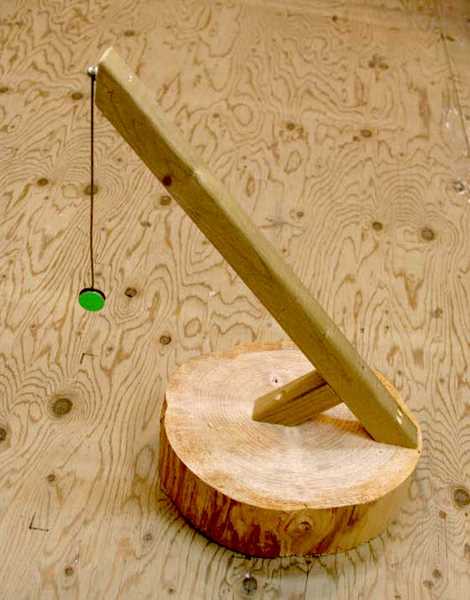
I like to make my own spinner targets.
Spinners for plinking
Plinking small reactive targets at random ranges is my favorite airgun passtime and spinners are my preferred targets. Today I will share how I make them.
I like spinners because they are an all-or-nothing kind of target. Hit them and they spin. Miss and they just sit there, waiting for you to try again. The instant feedback of a hit confirms that the sight picture was correct for that range. The way they move when hit allows you to discern whether you just clipped the spinner or smacked it dead center. Excellent training for hunting!
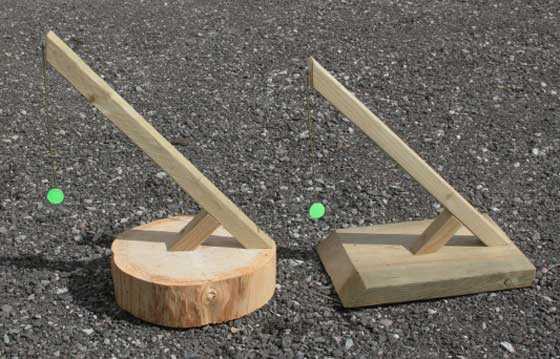
The bases can be anything.
There are many commercially made spinner targets available on the market but, being a compulsive tinkerer, I prefer to make my own from stuff I have around the house.
The targets I show here are best for air guns up to about 20 foot-pounds, which is about 27 joules. They can be used with more powerful rifles, but the wire arm may need more frequent replacement.
Construction
All you need are few basic tools and some hardware — a length of stiff wire and some wood for the base. Construction is simple, many of the best track saws will get the job done and you can easily make a half a dozen spinners in an evening.
To help form the wire, a simple bending jig is made from a piece of spruce 2×4 lumber that has a good solid knot and a 2-inch long, quarter-inch diameter bolt. To make the jig, drill a quarter-inch hole through the knot and install the bolt as shown in the picture below. Immediately beside the protruding bolt, drill an eighth-inch diameter hole about an inch deep. The eighth-inch hole holds the end of the wire while the coils are formed around the bolt.
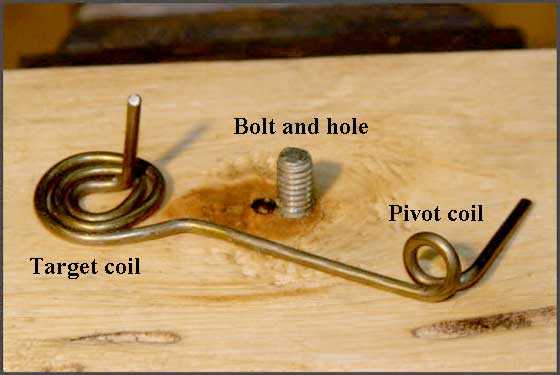
This 3-inch spinner arm was made to show details of the large target coil and the small pivot coil, their orientation and the jig that’s used to bend them. An actual finished arm is about 10 inches long.
Form the spinner arm
The spinner arm is made from a 16- to 17-inch piece of stiff wire. Coat hanger wire works well, and one hanger will yield enough wire for two spinner arms.
To form the large target coil, bend the last three-quarter-inch of wire into an L shape and insert the short piece into the hole in the jig. Keeping the wire flat against the wood jig, bend it around the bolt (in one continuous motion) to form a 2-1/2-turn spiral (refer to the photo above). Pry the flat coil off of the jig with a screwdriver, cut off the short bit of wire and file the stub flush with the coil.
Form the pivot coil
Form the small pivot coil by making another L on the other end of the wire. This L end is also about three-quarters of an inch long, and is in the same plane as the target coil – in other words, this L should be flat on the table when the large coil is flat on the table. Insert the wire into the jig and form a 1-1/2-turn coil (like a spring) around the bolt. Remove from the jig and cut off the short bit of wire and part of a coil. Flatten and close the coil to create the pivot as shown in the next photo. Check that the target coil is at 90 degrees to the pivot coil and adjust if required.
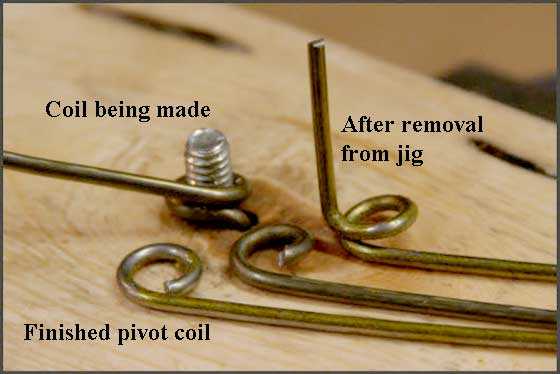
This shows how the pivot coil is made.
Assembly
Assemble the spinner target from two fender washers, a lock washer and a machine-screw with a nut to fit it. Clamp the large target coil between the washers and tighten the machine screw nut securely. If required, use a pair of pliers to bend the wire arm so that its axis is aligned with the center of the bolt as shown below.
Note that I am using heavy washers and 1/4-20 hardware for these spinners because they are for my .22 and .25 caliber PCPs. Lighter bolts and nuts can be used for .177 air guns.
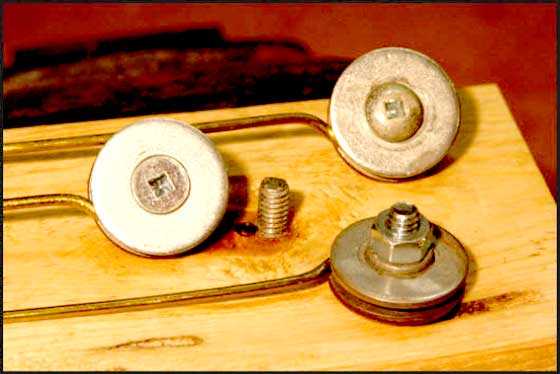
Three finished spinner targets show assembly details.
The target base
The target base can be anything that will support the spinner. I’ve attached the spinner arms to fence posts, trees or a just a stake driven into the ground. The base needs to be wide and heavy enough to be stable.
The base shown at the beginning of the blog is made from a 3” thick slice of log and a 2×2 baluster left over from when I built my deck. I prefer a portable base to be able change locations easily.
Spinner mounting
The pivot end of the spinner is attached to the base support using a woodscrew, two washers and a disk of soft foam. The foam serves to space the spinner arm away from the mounting point and provides some tensioning to dampen the arm movement.
The pivot should fit loosely on the screw to allow it to move about freely. If the spinner arm is constrained too much it will be forced to absorb the energy of impact rather than being able to move out of the way.
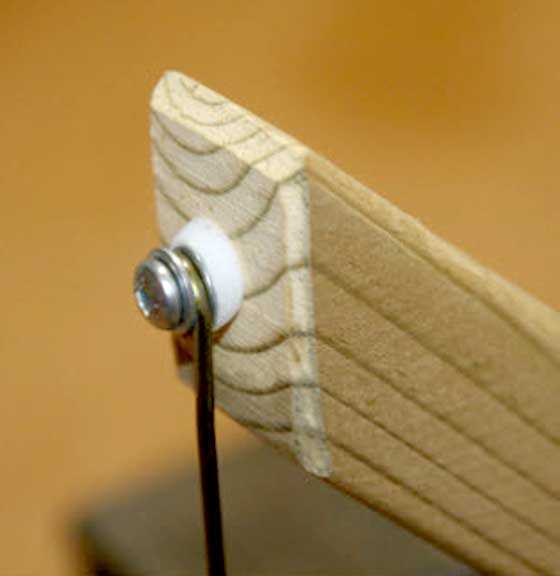
This is how to mount the pivot to the spinner base.
Cautions
All the usual safety precautions apply to using these targets… use safety glasses; shoot at a reasonable range and have a good backstop.
These spinners are NOT recommend for steel BBs – the metal target face is perpendicular to the shooter and the probability of the BB rebounding directly back at the shooter is very high.
Spinner target use
I like to deploy a dozen or so of these spinners along the walking trail on my property and moving them to different locations frequently. It’s great practice to stalk them and take the shot through whatever clear lane you can find through the bush. Since the spinners are the size of the kill-zone on most small game you can quickly learn your maximum effective range.
Summary
Pop-cans are the traditional plinking targets of airgunners but if you want a greater challenge, I suggest you try these spinners.

Hank,
Thank you for the wonderful instructions. I suppose the washers are an inch in diameter or are they smaller? The foam washer is a wrinkle I wouldn’t have thought of. That definitely helps the spinner moving freely and allows it to transfer the energy as motion instead of taking it all by the direct hit.
Siraniko
Siraniko,
Glad you enjoyed the spinner plan. Yes, I use 1 inch washers. I’ve kind of standardized on that size because I can relate that diameter to the small game that I hunt – helps me judge the distance better.
The foam serves as a flexible spacer that keeps the spinner arm away from the mount and allows it freedom to pivot and rotate. It also helps to dampen the arm rotation a bit.
Hank
Very nice design! I made a couple of attempts at building a spinner attachment for my silent pellet trap (Archer Airguns style but home built) but neither of them worked all that well. With my first attempt I discovered that even with a sub-500FPS gun and lead pellets that a target made of aluminum isn’t tough enough! I think I can adopt some of your design elements and make a much better version.
What an elegantly simple project. Very nice guest blog Hank.
Rich
Hank,
Most excellent article and fine looking spinners. I like the foam idea. I suppose a small spring would accomplish near the same effect. Good advice on finding one’s effective range.
Now that we have had “Spinner 101”,… how’s about “Stock Making 101”? Nothing fancy, just the (basic) steps along the way, some pics and some of the tools that you used. I have seen your work and it is nothing short of astounding.
Lamination of different woods is nice, but perhaps not for a 101 class. A fair bit of pics would minimize the text. Something to think about for (next time) you are making one. You have mentioned that it can be done with “basic” tools. I think many of us find that hard to fathom.
Fine job on the report and nice pics. Very clear.
Good Day all, Chris
I second the request for Stock Making 101
Stock making 101 is a possibility, will think about it.
Hank
Hank,
Thanks for the great idea and design. I just made one out of scrap iron, bailing wire and bottle caps. It requires constant repairs. I will be using your design on the next one. Maybe tomorrow, guess I mean latter today.
Glad you mentioned safety. I had a “pellet” bounce back off a plastic spinner a couple years ago and hit me right between the legs. Took the fun out of shooting that day.
Don
Hey Hank,
A most excellent report! I have a feeling Caldwell, Casey and a few other companies are not going to be happy with you shortly!
By coincidence, I have been pondering spinners lately. Most I have seen are too large, being 1-1/2″ or larger in diameter. My preference is 3/4″ as if I can hit that, I feel comfortable with my performance.
This allows me to make some any size I want and in quantities that I can scatter about without having to move them while plinking. Nice idea about using them along a trail. It would be easy to mount some on trees.
Any ideas on one that can stand up to about 100 FPE? 😉
RidgeRunner,
Would a 2 inch long 3/4 inch stovebolt with 2 nuts suffice? Add more nuts off more mass desired.
Siraniko
Siraniko,
I do not think the wire would stand up to such. I was shooting free hanging steel plate approximately 1/16″ thick at 100 yards with this rifle and it was making a considerable dent in it.
RR,
.22 rimfire spinners should be able to handle that level of energy.
It would be easy enough to make 100 fpe spinners but it would require custom made components to be welded together.
Hank
Hank,
I have a 3/4″ spinner made by Steel Plinkers that can probably take it and he makes some field targets that will supposedly take it.
I can see me making some of these for my other air rifles.
RR
Thanks for an interesting report. I like your ideas. Gives me “food for thought”.
Until now, my home made spinners have been small bent spoons just hanging down.
Really like your spinner arms….other than coat hanger wire, what other type of wire would you recommend?
FYI-all I can find around the house are plastic hangers. LOL!
-Y
Thank you for the great idea. I would use the wire for a drop ceiling as that is more available to me than coat hangers.
Thanks to all for your kind words – glad that you find my design of interest!
And, thank you Tom for the edits and tweaks to my submission – notes taken for the next time. 🙂
Hank
Hank,
Both your submission and Benji-don’s were well-written, and you both followed my instructions well. One thing for you though. Pix are 560 pixels wide, not 530.
I enjoyed reading you report as I edited it. I learned a lot, and I may make some of these spinners!
Thanks,
B.B.
Yogi,
As Gopher mentioned, “drop ceiling” wire is excellent. One-eight inch mild steel welding rods are great as well.
Coils of stiff wire used for tensioning chain-link fences works as well. Vinyl coated and bare wire is available.
Hank
Great idea for a reactive target! I like your idea of placing them along a walking path and changing the locations, sort of like 3-D archery. I make a reactive target out of old CO2 cartridges. Use a screen door spring and force it over the neck, and hang , no steel BB’s.
I just got this question from Ray:
——————————————————
Wasn’t sure how to reach you so using this venue. Was wondering about safety issue on pcps with regard to repeated pressurization
over the years.Most pcps are newer and certainly built with margin
of safety,but is it possible as these age and perhaps are handed down
that they (the pressure vessel) can become unsafe? Read somewhere
repeated pressurization can lead to eventual metal fatigue (in relation to
high pressure vessels of non air rifle type). Thinking of future owners
down the road.
Thanks for all you do for all us airgun fans,read blog everyday.
——————————————————————————————-
Folks, I can’t answer direct questions. I get close to 200 emails on busy days and it’s too much. Post your questions here and I will answer them here.
B.B.
Ray,
I’m sure I have addressed this in several past reports, but perhaps never as a specific topic. This is a very good question that deserves at least a full report, if not a series. I will start answering you next week.
Thanks for a good topic,
B.B.
B.B.,
Here you were speaking of “work-hardening” related to scuba tanks and hydrostatic testing. I suspect this may apply to PCP air tanks and couplings over a period of time, especially the ones that fill to the higher psi.
/blog/2005/11/scuba-tanks-for-precharged-airguns/
Although this next one is different, and new to me, it seems to well explain the need to have and apply knowledge of natural phenomena carefully to avert catastrophe. In this case the phenomena are aeroelastic flutter and resonance vibration. The video of the Tacoma Narrows Bridge is more dramatic to see, but the issues with aircraft are equally consequential, especially for anyone aboard the plane.
http://aviation.cours-de-math.eu/ATPL-081-POF/flutter.php
~ken
Ken,
Thank you for that link. I will use it when I write the next report.
B.B.
Hank,
This is a very well-written, thoughtful, and useful report; thank you.
take care,
dave
Thanks, Hank;
Excellent job! This is the kind of DIY we lived by all my life. You used what materials were on hand and applied a touch of ingenuity and the task was done. Life was simplistic out of necessity and I still prefer it that way. It slows down the hectic pace we set for ourselves these days.
Hank
Cool spinners. I make mine too. Not as cool as yours but they work.
I take a piece of wire coat hanger and bend it in a square like this l_l about 8″ by 8″ on all 3 sides then flip it the other way and put the legs in the ground. But first I put a I lttle V bend in it and make a a wire hook with a loop in it and attach it at that V bend I made. That keeps the hook in place but allows it to spin over the top.
Now for the actual target. I take some 1/8″ thick angle iron and cut it in a 1-1/2″ length. At the top I drill a hole in it where the point of the angle is. Now I attach it to that wire hook I made on the square wire frame with the open part of the angle iron facing me.
Works real nice. When a pellet or bullet hits it. It gets directed to the inner point of the angle iron and then sends the pellet or bullet downward as the spinner spins. The biggest round I have shot at it is .22 long rifle and my .25 Marauder. No problems at all. Don’t know how old they even are now.
I’m at work or I would post a picture. It’s alot simpler than it sounds with me explaining it. I’ll post one later when I get home this evening.
GF1
Your description is good and I can visualize what you are describing. Bet they “ring” real nice when you hit them. 🙂
I’ll make up a couple for the FX500 to beat on – thanks for the idea.
This might be just the design for RidgeRunner. Think he would have to use at least 1/4″ wire for the support frame though.
Hank
Hank
The coat hanger wire actually acts as a shock absorber.
Make you up one and see what you think.
I also hang beverage cans and old cough medicine bottles and such from the wire hook.
Hi BB and Hank, excellent set of instructions! ….love these DIY blogs! One question for either of you, although not recommended for steel BBs would these or commercial spinners be OK for alloy pellets. Alloy pellets, being much harder, will not deform as lead do.
Regards,
Peter
Off subject, several have asked for more choices in a PCP with an onboard pump….this rifle has lots of “firsts” and looks very interesting. At the IWA show is an article from Hard Air:
https://hardairmagazine.com/news/nova-vista-hp-m1000-multi-pump-pcp-air-rifle/
Doc,
I will be keeping an eye on that one. If it is accurate and reliable I can overlook some of its bulk. It has most of the features we have been talking about. Sounds like the price is going to be very good for a gun with all those features.
Don
Doc
Now that’s a interesting gun.
Doc,
Very nice. That is a lot of what people have been asking for. I like the innovations. Thanks.
Hi Peter,
I shoot JSBs most of the time and have no experience with the alloy pellets.
The alloy pellets may not deform like lead but at the energy levels that are typical these days I am sure that they will deform on impact.
Might be interesting to shoot one into a bucket of water to see what happens – I know the impact to the water will deform lead pellets.
On these spinners, soft lead pellets travelling over 700 fps tend to break up on impact (which I think is a good thing as the fragments loose their energy rapidly and there is little left to ricochet).
That the alloy pellets are harder and less ductile than lead I suspect the they will be even more inclined to fragment than lead pellets. I am just speculating, maybe B.B. has other thoughts about this.
I’ll just reiterate, steel BBs (especially considering they are usually low velocity and used at closer ranges) would be very dangerous to use on this sort of target.
Hank
Reactive targets are the best. Currently mine consist of dirt clods at the shooting range and one self-healing target in the shape of a sphere that ricochets at the distances I shoot at. I can’t seem to find the size of your target or the distances you shoot at. If your targets are set up for a walk in the woods, then it sounds like you shoot offhand which would make them even more challenging.
flintrocker, I don’t think anything is wrong with my 747. It shoots great. I suppose I am just referring to my subjective sense of compressing air directly rather than through a spring. Gunfun1, that’s good to know that other pump guns feel solid. As for my friend, Lauren, she is working overseas as a foreign service officer, so she had to leave her airguns behind.
Matt61
Matt61
I use a 1 inch washer for my spinners and have been bench-shooting them up to 55 yards from a rest. I usually don’t paint my spinners so they blend into the background – just like rabbits do.
I recently acquired a FX 500 and am anxiously awaiting decent weather to see how much I can increase that distance. 🙂
I bench shoot to learn the sight picture then I switch to offhand shooting at random distances. When going for a walk-about I will stand, sit or kneel as well as using trees and such when shooting – just as I would if I was hunting. By the time the hunting season comes around I have a really good idea of what my effective range is.
Hank
Matt61
You mentioned that about your friend a little while back when we was talking. I just couldn’t remember what gun you said you got her.
Wire hangers? WIRE HANGERS?!? NO WIRE HANGERS EVER!!
https://www.youtube.com/watch?v=XOILKHmZBwc
Haha, just kidding. Thanks for the DIY Hank.
Funny LOL!
NO WIRE HANGERS EVER!! …Now that is a scary thought – along with duct tape and WD-40, wire hangers are a critical source of materials for my shop!
Hank
Hank
They will take my wire hangers, my duct tape, my WD-40, my JB Weld and my bicycle inner tubes when they pry them out of my dead cold fingers.
I’m happy you liked the joke. Looking forward to your next guest blog.
Since people are sharing their ricochet stories, warnings,… I set up a nice 1 1/2″ x 1 1/2″ block, 4″ long and fired a .177 pellet from 24′ with my 92FS pistol. The block was free to move and fall into my substantial indoor trap.
Well, the block did fall. Also,.. the lead pellet ricocheted back,.. hit a wall to my right,.. continued to the wall just behind ME,.. and continued on into the kitchen. That was the 1 and only time I tried that. The trap has a 1/8″ steel plate in the back and works fine for .22 pellets. Through target, hits steel. Splat,.. fall. No problem.
If the block had been solid, nothing would have happened. The fact that it was free to move meant that all of that energy could not be absorbed. This has nothing to do with Hank’s spinners,.. just a cautionary tale for anyone that cares to take note.
Chris U
True to a point. All depends on the energy the pellet has.
GF1,
Yup,.. all that energy stuff factors in. I’m just sayin’ that particular combo did NOT work. The TX or LGU would have split it and the .25 M-rod would have shredded it.
By the way,.. after the chrony work with the M-rod awhile back, the 1 1/2″ thick wood was split up pretty good. I tried to keep all the shots in the same area. Well,.. I got into it the other day and there was a ball of lead that would add up to the size of a golf ball. 4 x 4 “absorption” next time. The wood did work in keeping the 5 ft. from muzzle,.. to 1/8″ plate,.. damage to 0%.
Chris U
Yep on all.
I just hang ferral plastic pill containers from a branch or a string tied between 2 trees. I also use plastic bottle caps. Several brands of orange juice use 3-4″ orange caps. Besides being reactive, they break up like clay shotgun targets.———-Ed
I was shooting at an empty insectide can with a low powered Gamo Gamatic (multi shot 68 XP) a rws hobby .177 struck a glancing blow on the rounded top of the can just below the dispenser hit a solid concrete wall behind at an angle and bounced back 50 feet to land in my lap! The pellet retained all the evidence of its journey; a shiny blaze on the side of the head and skirt and a roughened flattened head where it impacted the concrete! Apart from those impact marks the pellet retained its basic shape. That can was not shot at again.